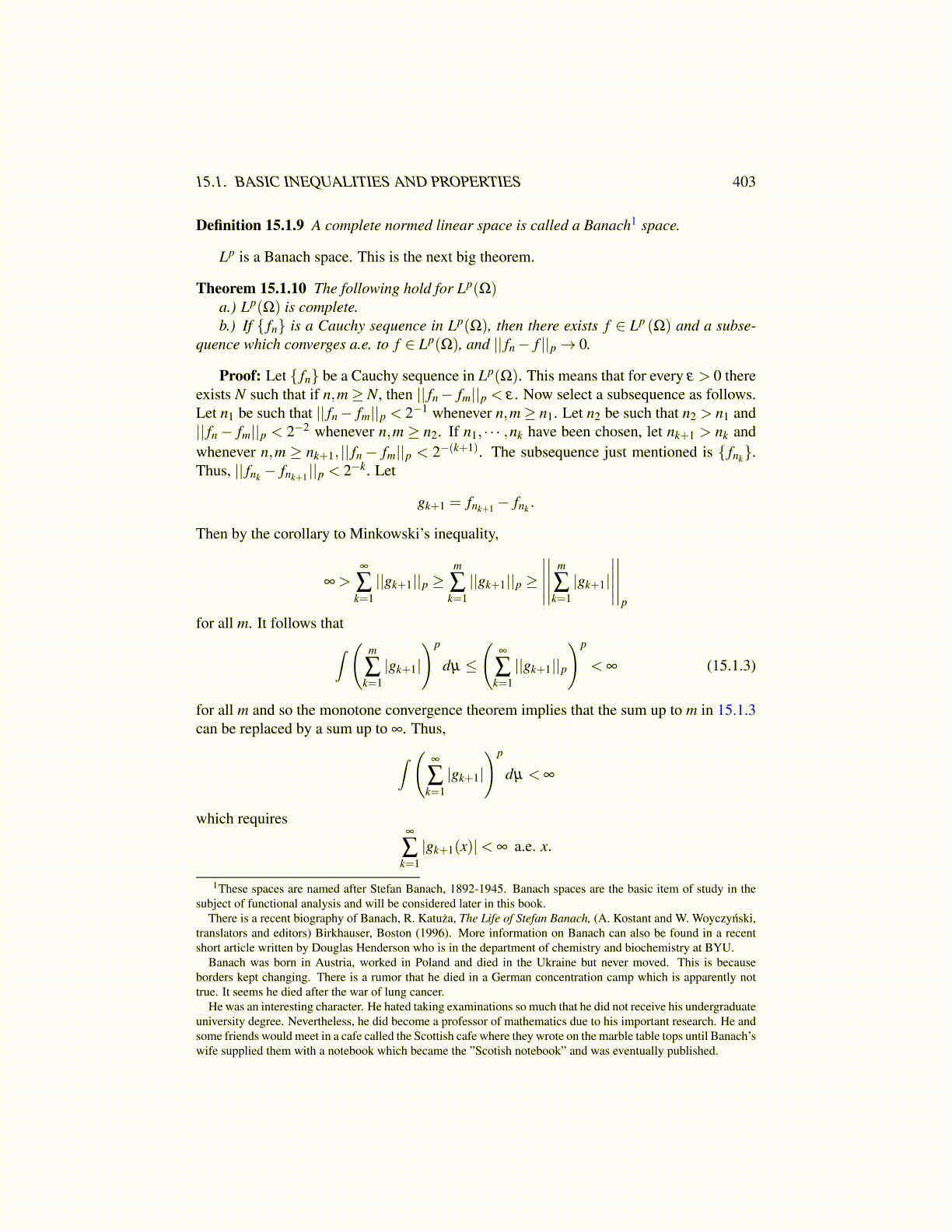
15.1. BASIC INEQUALITIES AND PROPERTIES 403
Definition 15.1.9 A complete normed linear space is called a Banach1 space.
Lp is a Banach space. This is the next big theorem.
Theorem 15.1.10 The following hold for Lp(Ω)a.) Lp(Ω) is complete.b.) If { fn} is a Cauchy sequence in Lp(Ω), then there exists f ∈ Lp (Ω) and a subse-
quence which converges a.e. to f ∈ Lp(Ω), and || fn− f ||p→ 0.
Proof: Let { fn} be a Cauchy sequence in Lp(Ω). This means that for every ε > 0 thereexists N such that if n,m≥ N, then || fn− fm||p < ε . Now select a subsequence as follows.Let n1 be such that || fn− fm||p < 2−1 whenever n,m≥ n1. Let n2 be such that n2 > n1 and|| fn− fm||p < 2−2 whenever n,m ≥ n2. If n1, · · · ,nk have been chosen, let nk+1 > nk andwhenever n,m ≥ nk+1, || fn− fm||p < 2−(k+1). The subsequence just mentioned is { fnk}.Thus, || fnk − fnk+1 ||p < 2−k. Let
gk+1 = fnk+1 − fnk .
Then by the corollary to Minkowski’s inequality,
∞ >∞
∑k=1||gk+1||p ≥
m
∑k=1||gk+1||p ≥
∣∣∣∣∣∣∣∣∣∣ m
∑k=1|gk+1|
∣∣∣∣∣∣∣∣∣∣
p
for all m. It follows that∫ ( m
∑k=1|gk+1|
)p
dµ ≤
(∞
∑k=1||gk+1||p
)p
< ∞ (15.1.3)
for all m and so the monotone convergence theorem implies that the sum up to m in 15.1.3can be replaced by a sum up to ∞. Thus,
∫ ( ∞
∑k=1|gk+1|
)p
dµ < ∞
which requires∞
∑k=1|gk+1(x)|< ∞ a.e. x.
1These spaces are named after Stefan Banach, 1892-1945. Banach spaces are the basic item of study in thesubject of functional analysis and will be considered later in this book.
There is a recent biography of Banach, R. Katuża, The Life of Stefan Banach, (A. Kostant and W. Woyczyński,translators and editors) Birkhauser, Boston (1996). More information on Banach can also be found in a recentshort article written by Douglas Henderson who is in the department of chemistry and biochemistry at BYU.
Banach was born in Austria, worked in Poland and died in the Ukraine but never moved. This is becauseborders kept changing. There is a rumor that he died in a German concentration camp which is apparently nottrue. It seems he died after the war of lung cancer.
He was an interesting character. He hated taking examinations so much that he did not receive his undergraduateuniversity degree. Nevertheless, he did become a professor of mathematics due to his important research. He andsome friends would meet in a cafe called the Scottish cafe where they wrote on the marble table tops until Banach’swife supplied them with a notebook which became the ”Scotish notebook” and was eventually published.